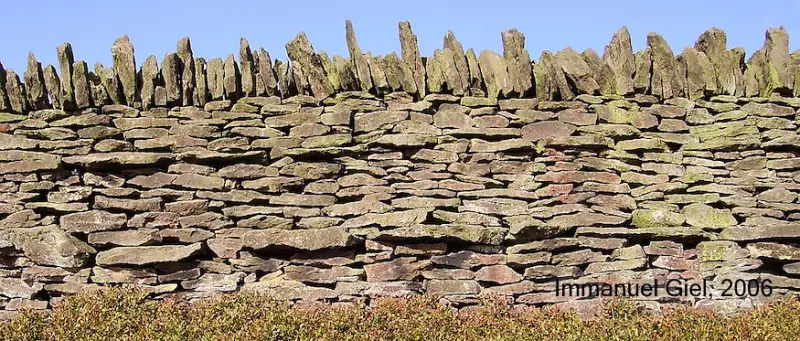Dry Stone Walls in Combe Martin
Published on July 02, 2025
This article is covered under the CC BY-NC-SA 4.0 license | Non-Commercial | No Derivatives
Related articles: Combe Martin Lime-burning and Quarrying | Geology of Combe Martin

Combe Martin’s distinctive dry stone walls define its landscape, shaped by local geology and traditional craftsmanship passed down through generations.
In North Devon, wall styles vary—stones may be laid horizontally or vertically, depending on shape, tradition, and location. Devon’s stone-faced banks often showcase upright placements.
These styles are a reflection of material availability, intended function, and cultural preference—giving the area its signature wall character.
A distinguishing feature of many walls in the South West of Ireland is that the stones are aligned vertically, a feature only found in Southern Ireland and in the south west of England.
Built without mortar, the walls rely on local slate, limestone, and sandstone from the Devonian period, creating a durable and regionally distinctive appearance.
The technique draws on local resources and long-standing skills developed in the community.
Once primarily used for field boundaries and livestock management, their use expanded as agriculture overtook mining in the region.
Although dry stone walling is found across Britain, Combe Martin’s examples reflect specific local traditions—stones are precisely shaped and placed by hand, held in place solely through weight and friction.
Many visible walls date from the 18th to 19th centuries, coinciding with enclosure movements, though some may mark older boundaries.
These walls serve both practical and historical purposes, connecting modern-day Combe Martin to its rural roots.
They reinforce the village’s rural character and showcase visible heritage and craftsmanship.
The tradition endures today, supported by local knowledge and organizations like the Dry Stone Walling Association.
References
Wall styles range from horizontal to vertical, depending on material and purpose:
Horizontal walling: Common in many areas. Stones are stacked flat to distribute weight and ensure strength.
Widely regarded as the most stable form (Peak District Guide, ExplainThatStuff, Architettura di Pietra).
Vertical styles: Typical in Devon and parts of southern Ireland. Stones are placed upright, resembling books on a shelf.
This method, known as vertical wedging, is ideal for sloped terrain and soil retention (Gathering of Stones, Stone Trust).
Vertical coping: Upright stones placed on top improve drainage and discourage livestock from crossing (ExplainThatStuff, Michael Hornsby PDF).
Style choices reflect local needs, geology, and custom. Horizontal walls emphasize stability, while vertical types highlight function and regional identity (1, 2, 3).
- Gathering of Stones - Wall Types
- Peak District Dry Stone Walling PDF
- ExplainThatStuff - Dry Stone Walls
- Dry Stone Walling Standards
- Stone Trust - Polygonal Masonry
- Architettura di Pietra Article
- Reddit Discussion on Wall Building
- Michael Hornsby PDF on Dry Stone Walls
Large upright slabs and columns in these walls, often called "orthostats" by archaeologists, are a local hallmark in Combe Martin. Though practical, they also carry historical significance.
Why Use Upright Stones?
Structure: Helps prevent wall bulging, especially on uneven ground.
Markers: Denote field edges or ancient trackways.
Geology: Wide, flat stones from the local geology lend themselves to vertical placement.
Visual Impact: Creates a rhythmic, distinctive appearance in the landscape.
Summary
Next time you're visiting Combe Martin, Ilfracombe, or Lynton and Lynmouth, examine the many dry stone walls, and admire the skilled work.
Their horizontal or upright features blend functionality with tradition, enhancing Combe Martin’s landscape and reflecting its unique heritage of materials, skill, and identity.
Article copyright Author, © 2025 All rights reserved | Terms of Use
Attribution: "Combe Martin Dry Stone Walls", © Combe Martin Village History Project, licensed under CC BY-NC-SA 4.0.
![Combe Martin Village History [The Little Parish with a Big Story] Combe Martin Village History [The Little Parish with a Big Story]](https://primary.jwwb.nl/public/i/j/k/temp-bexcyixkrnloblaipglr/cmvhp-logo-01-june-2025-high.png?enable-io=true&enable=upscale&height=70)
![Combe Martin Village History [The Little Parish with a Big Story] Combe Martin Village History [The Little Parish with a Big Story]](https://primary.jwwb.nl/public/i/j/k/temp-bexcyixkrnloblaipglr/cmvhp-logo-01-june-2025-high.png?enable-io=true&width=100)


